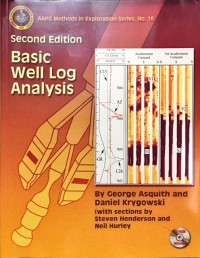Record Detail
Advanced Search
Text
Basic Well Log Analysis
As shown in the previous chapters, determining the porosity and true resistivity of a zone is the first step in converting the raw log data into estimated quantities of oil, gas, and water in a formation. These estimated quantities are used to evaluate a zone and to determine whether a well completion attempt is warranted. This chapter covers some of the different methods from which these estimates are derived. The methods discussed are: Archie water saturations (Sw and Sxo) and the ratio method, quick-look technique, bulk volume water (BVW), and saturation crossplots (Pickett plots and Hingle plots). Determination of log-derived permeability (Ke) and shaly sand analysis are also discussed.
As important as this log-derived information is, however, it should not be applied without the inclusion of other data. This statement is, perhaps, obvious to the reader, but it can’t be overemphasized. A geologist should always consider every item of relevant data, such as drill stem tests, sample shows, mud-log analysis, nearby production, etc., before making a decision to set pipe.
(TERDAPAT TEACHING MATERIALS YANG DAPAT DIUNDUH PADA MENU E-RESOURCES)
Availability
| 6440/PUP/2018 | 622.3381 ASQ b c.1 | Perpustakaan Universitas Pertamina | Available |
| 6441/PUP/2018 | 622.3381 ASQ b c.2 | Perpustakaan Universitas Pertamina | Available |
Detail Information
| Series Title |
-
|
|---|---|
| Call Number |
622.3381 ASQ b
|
| Publisher | Ameican Association of Petroleum Geologists : Oklahoma., 2004 |
| Collation |
xi, 244 p. : Illust. ; 28 cm
|
| Language |
English
|
| ISBN/ISSN |
9780891816676
|
| Classification |
622.3381
|
| Content Type |
-
|
| Media Type |
-
|
|---|---|
| Carrier Type |
-
|
| Edition |
Ed. 2nd
|
| Subject(s) | |
| Specific Detail Info |
-
|
| Statement of Responsibility |
-
|
| Department(s) |
Other version/related
No other version available











